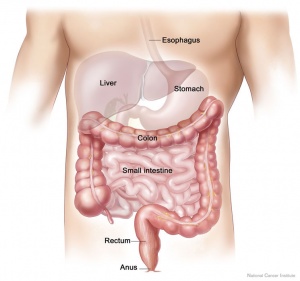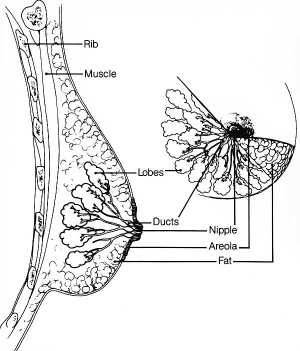BGDB Gastrointestinal - Postnatal
| Practical 1: Trilaminar Embryo | Early Embryo | Late Embryo | Fetal | Postnatal | Abnormalities | Lecture | Quiz |
Birth
Birth leads to changes in many different systems. Within the context of this Practical class we will look at just a few GIT changes at birth and during the neonatal period (first 4 weeks). A complete understanding requires knowledge of several other systems (respiratory, cardiovascular). Remember that the GIT as well as digestion and absorption of nutrients also has endocrine, neural and immunological functions.
![]() Guthrie test Issues related to metabolic disorders will be covered in GIT Abnormalities.
Guthrie test Issues related to metabolic disorders will be covered in GIT Abnormalities.
- The first stool (meconium) is passed within 24 hours in most healthy term infants.
- often delayed in infants with very low birth weight and may not occur until 1 week after birth or later.
- Many of the associated GIT organs and the tract (both motor and secretory) functions have commenced function during the late fetal period and the early neonatal GIT has a number of unique properties.
- The GIT epithelium has receptors which help internalise antibodies present in maternal milk, to aid continued maternal passive immunisation, prior to establishment of the newborn immune system.
- The intestinal tract also requires populating postnatally with microorganisms (flora) which are mainly bacteria aerobic and anaerobic, but may also include yeast and fungi.
- Treatment of infection with antibiotics can alter this bacterial population. (More? Gut Microorganisms)
- The infant has many different signs that indicate a need for feeding: restless, crying, sucking fingers (or anything) close to mouth. Smell is also used to turn the head towards a source of milk. I have included on this page some links to Nutrition information and also look at the Additional Resources for further readings. (More? milk)
- Abnormalities of face development (cleft lip and cleft palate) can affect the ability of the infant to feed, a "liquid seal" is formed by the mouth during feeding. (Clefting will be covered in BGD Face Development Practical)
Meconium
As introduced in fetal development, meconium is formed from gut and associated organ secretions as well as cells and debris from the swallowed amniotic fluid. Meconium accumulates during the fetal period in the large intestine (bowel). It can be described as being a generally dark colour (green black) , sticky and odourless.
- In fetal development, meconium is formed from gut and associated organ secretions as well as cells and debris from the swallowed amniotic fluid.
- Meconium accumulates during the fetal period in the large intestine (bowel).
- It can be described as being a generally dark colour (green black) , sticky and odourless.
Normally this meconium is defaecated (passed) postnatally over the first 48 hours and then transitional stools from day 4.
Abnormally this meconium is defaecated in utero, due to oxygen deprivation and other stresses.
Meconium Aspiration Syndrome
- Premature discharge into the amniotic sac can lead to mixing with amniotic fluid and be reswallowed by the fetus.
- This is meconium aspiration syndrome and can damage both the developing lungs and placental vessels.
Postnatal Abnormalities
- Absence or delayed passage of meconium may indicate conditions associated with meconium plugs or more seriously, Hirshsprung's disease (aganglionic colon, megacolon).
- Delayed conversion to transitional stools may indicate a feeding issue.
Nutrition - Milk
Breast milk makes us mammals! A review article by Goldman[1] may provide a way of thinking about GIT and human milk.
- "Human milk contains agents that affect the growth, development and functions of the epithelium, immune system or nervous system of the gastrointestinal tract. Some human and animal studies indicate that human milk affects the growth of intestinal villi, the development of intestinal disaccharidases, the permeability of the gastrointestinal tract and resistance to certain inflammatory/immune-mediated diseases. Moreover, one cytokine in human milk, interleukin (IL)-10, protects infant mice genetically deficient in IL-10 against an enterocolitis that resembles necrotizing enterocolitis (NEC) in human premature infants.
There are seven overlapping evolutionary strategies regarding the relationships between the functions of the mammary gland and the infant’s gastrointestinal tract as follows:
- certain immunologic agents in human milk compensate directly for developmental delays in those same agents in the recipient infant
- other agents in human milk do not compensate directly for developmental delays in the production of those same agents, but nevertheless protect the recipient
- agents in human milk enhance functions that are poorly expressed in the recipient
- agents in human milk change the physiologic state of the intestines from one adapted to intrauterine life to one suited to extrauterine life
- some agents in human milk prevent inflammation in the recipient’s gastrointestinal tract
- survival of human milk agents in the gastrointestinal tract is enhanced because of delayed production of pancreatic proteases and gastric acid by newborn infants, antiproteases and inhibitors of gastric acid production in human milk, inherent resistance of some human milk agents to proteolysis, and protective binding of other factors in human milk
- growth factors in human milk aid in establishing a commensal enteric microflora"
(Text from: Goldman ref[1])
- Links: milk
Gut Microorganism Population
The normal newborn gastrointestinal tract contains little if any microorganisms (commensal intestinal microbiota, microbiota, flora, microflora). Postnatally, the tract has to be populated by microorganisms, which are mainly anaerobic bacteria and then aerobic bacteria, but may also include yeast and fungi. The foregut comparatively has few microorganisms when compared to the midgut and hindgut.
Infections
There are several infectious pathogens that can populate the postnatal gut leading to a number of different diseases:
- Escherichia coli (enterotoxigenic)
- Shigella a gram-negative, non-spore forming rod-shaped bacteria infectious through poor hygeine and ingestion, fecal–oral contamination. (More? Dysentery)
- Vibrio cholerae
- Listeria
Antibiotics
Treatment of other neonatal infections systemically with antibiotics can alter the bacterial population.
Necrotizing Enterocolitis
- (NEC) is a disease affecting infants born prematurely, affects 5–10% of infants born weighing less than 1500 g.
- mortality rate of 15-30%
- usually occurs in the second week of life after the initiation of enteral feeds
- pathogenesis is multifactorial
- appears to involve an overreactive response of the immune system to an insult.
- increased intestinal permeability, bacterial translocation, and sepsis.
Adult

|

|
| Gastrointestinal Tract Terms | ||
|---|---|---|
| ||
|
Additional Information
| Additional Information - Content shown under this heading is not part of the material covered in this class. It is provided for those students who would like to know about some concepts or current research in topics related to the current class page. |
Milk Immune Function
The neonatal immune system (innate and adaptive) is immature and still developing, and there is now good evidence that milk contributes to the developmental process, see review.[2]
In addition to maternal antibodies, milk contains maternal lymphocytes (antibody-producing B cells. T cells, and natural killer cells). In a mouse model, maternal cytotoxic T cells within milk transfer into to the neonatal intestinal Peyer's patches.[3]
References
- ↑ 1.0 1.1 Goldman AS. (2000). Modulation of the gastrointestinal tract of infants by human milk. Interfaces and interactions. An evolutionary perspective. J. Nutr. , 130, 426S-431S. PMID: 10721920
- ↑ Cacho NT & Lawrence RM. (2017). Innate Immunity and Breast Milk. Front Immunol , 8, 584. PMID: 28611768 DOI.
- ↑ Cabinian A, Sinsimer D, Tang M, Zumba O, Mehta H, Toma A, Sant'Angelo D, Laouar Y & Laouar A. (2016). Transfer of Maternal Immune Cells by Breastfeeding: Maternal Cytotoxic T Lymphocytes Present in Breast Milk Localize in the Peyer's Patches of the Nursed Infant. PLoS ONE , 11, e0156762. PMID: 27285085 DOI.
| Practical 1: Trilaminar Embryo | Early Embryo | Late Embryo | Fetal | Postnatal | Abnormalities | Lecture | Quiz |
BGDB: Lecture - Gastrointestinal System | Practical - Gastrointestinal System | Lecture - Face and Ear | Practical - Face and Ear | Lecture - Endocrine | Lecture - Sexual Differentiation | Practical - Sexual Differentiation | Tutorial
Glossary Links
- Glossary: A | B | C | D | E | F | G | H | I | J | K | L | M | N | O | P | Q | R | S | T | U | V | W | X | Y | Z | Numbers | Symbols | Term Link
Cite this page: Hill, M.A. (2024, April 27) Embryology BGDB Gastrointestinal - Postnatal. Retrieved from https://embryology.med.unsw.edu.au/embryology/index.php/BGDB_Gastrointestinal_-_Postnatal
- © Dr Mark Hill 2024, UNSW Embryology ISBN: 978 0 7334 2609 4 - UNSW CRICOS Provider Code No. 00098G


